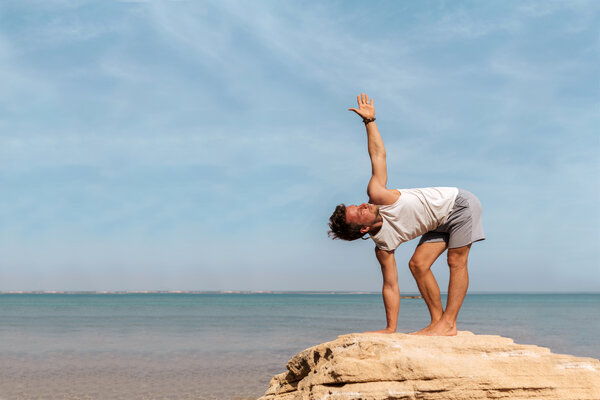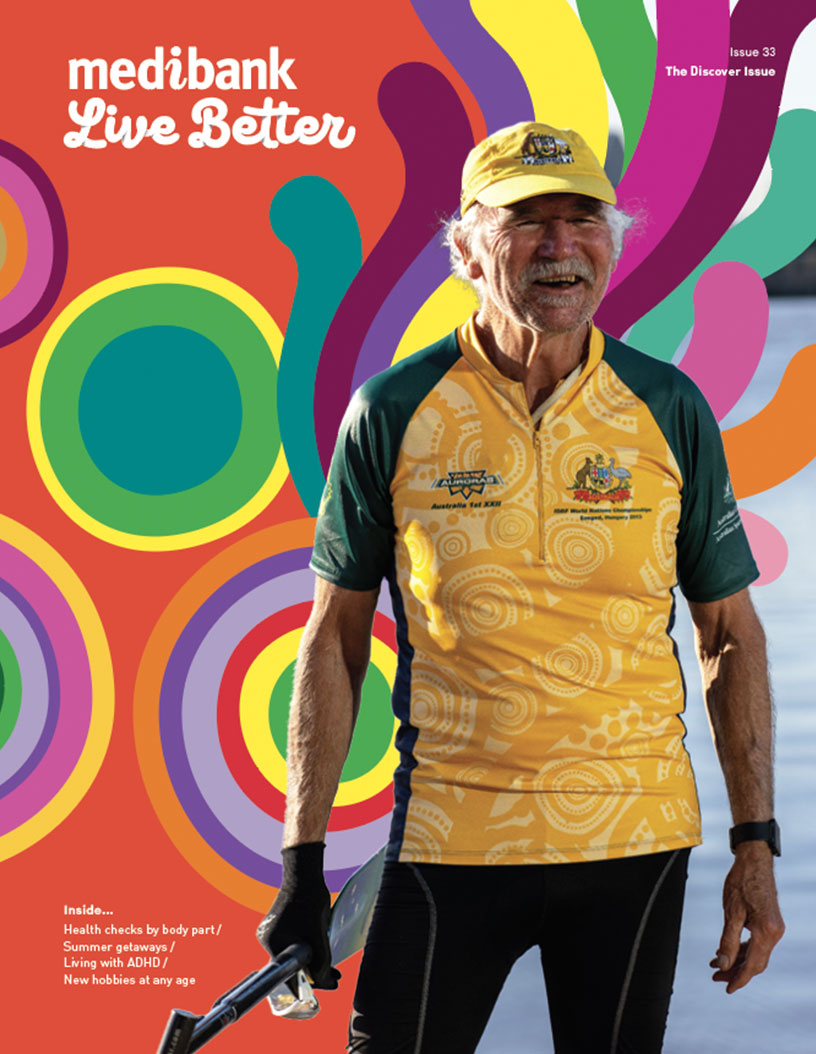Anthony Lett started doing Pilates when he was a 22-year-old student in Melbourne. At the time, he remembers there being only one Pilates studio in the city.
After studying sports science and working for a decade as a tennis coach, Lett opened his own yoga and Pilates studio in 2001.
“During that time Pilates really boomed everywhere, throughout the world — and it still is [booming],” he says.
In the 15 years that Lett ran his studio in Fitzroy, he thought deeply about how to integrate yoga with Pilates. He also noticed that, despite the increasing popularity of both practices, there was still a lack of men in his classes.
After founding another studio, StretchFit in Brisbane, Lett started a stretching program specifically for men.
“To try and get more men into my studio, I started a men’s-only program. We really simplified [the practice] and I called it ‘The Stiffies’, as a fun name for them,” he says.
Lett says simplifying the program really helped — both to suit his client’s bodies and to take out some of the embarrassment or trepidation they may have felt around more experienced students.
“We broke down the repertoire. I think, if men are looking for a class, they really need a teacher who can simplify things, so that they can focus on perhaps one muscle group and one joint at a time, rather than doing poses and such, which can be complicated.”
Lett says there are both “biomechanical aspects” and “hormonal aspects” to yoga and Pilates that can have huge health benefits — here’s how they could help you.
Yoga or Pilates?
While they have crossover elements, yoga and Pilates are distinct practices with very different origins.
Yoga is an ancient practice and philosophy that evolved in India more than 5000 years ago. It involves gentle movement, breath, and meditation, and was originally intended as a spiritual practice, to connect mind and body.
Pilates, however, is more focused on control of the body and muscular endurance. The practice was developed by its namesakes, Joseph and Clara Pilates, in their New York studio in the 1920s, and draws on techniques from yoga, ballet and calisthenics. It can be mat-based or involve equipment, such as the “reformer”.
Some studios, such as Lett’s, offer sessions that fuse yoga and Pilates techniques.
The benefits of stretching
Stretching practices are of course beneficial for all bodies, regardless of gender or life stage — but Lett says he has noticed some trends among his male clients.
Improved flexibility and posture
Stretching regularly can help you loosen up and, over time, significantly improve your posture.
“Men can be really stiff; I just finished with a group of men here and there was a new guy who could hardly put his shoes on,” says Lett.
Stretching helps move joints through their full range of motion, releasing tension and easing stiffness. Depending on the type of practice, it could also build strength and endurance. If you’re incorporating weight-bearing poses into your routine, it could even help prevent or manage osteoporosis or back pain.
“Once you start stretching, everything becomes a bit easier,” says Lett. “Maybe you can then start going for a run, or you can do other forms of exercise, or you can play with your kids or your grandkids — participate a bit more.”
Stress relief
Lett says the “hormonal aspect” of stretching is another huge benefit — especially for people who may be dealing with stress and at risk of conditions like diabetes, high blood pressure, or stroke.
“It's not woo-woo. When you stretch and relax, you switch on your parasympathetic nervous system, which helps with things like fighting bacteria and viruses,” he explains.
“You produce more white blood cells, your heart rate drops, your blood pressure drops, your arteries become more dilated, and you're less likely to have clots.
“All of those things are the hormonal responses to relaxation; when you get stressed, the opposite occurs.”
If you develop a regular yoga or Pilates practice, you may improve your circulation, concentration, sleep quality, energy levels, and general sense of wellbeing.
Avoid muscle imbalances
By incorporating variety into your exercise routine, you can build more even muscle tone and avoid imbalances that could cause complications later down the line, Lett says.
“For example, if your passion is running, you tend to develop only the muscles that you use when running and you can develop muscle imbalances.
“You don’t necessarily recruit all the muscles that would be recruited optimally, as a runner.”
Yoga and Pilates can help work different muscles in the body in a more holistic way. Pilates, for example, focuses on the core muscles of the body — the abs, lower back, hips, and buttocks — with the aim of improving overall mobility.
Injury recovery and prevention
In the early days of Pilates, the practice was particularly embraced by dancers who were mindful of injury, and found it useful for both prevention and rehabilitation. The focus on controlled, repetitive movement is a safe way to build muscle strength. By taking up the practice, Lett says, “you're less likely to get injured, which is important as you get older”.
How to find a yoga or Pilates class that works for you
Lett says there are a few aspects to consider when finding a yoga or Pilates studio near you.
It may be worth taking some one-on-one lessons to start with, to get a solid grounding in the practice, before taking group classes.
“I'd first book a couple of private lessons. Even though the initial expense may be a bit off-putting, I think it's worth it. You get individual attention; you can ask questions; you can get some assessments,” he says.
Lett says it’s also worth doing your research into the studio or teacher and their qualifications.
“You really need to ask: ‘What is the training of this person that I'm going to? What is their background?’ Without being too picky — but you don't want to just assume that they're well-qualified; you need to find out what training they've done.”
He says going through an organisation like the Australian Pilates Method Association, which lists trained Pilates teachers, could be a good place to start.
Remember to consult your GP before starting a new exercise program.
Don’t leave it too late
A final word of advice from Lett is to pick up a stretching practice sooner rather than later.
“Men tend to go to things like Pilates and yoga as they get older; their ego recedes a little bit and they start to be a bit more interested in how they feel rather how they look,” he says.
He recalls some of his clients who arrived in his classes with health complications and chronic issues that may have been preventable.
“They’re all broken and twisted, and they come in and say, ‘I wish I'd done this years ago.’
“So, a message to blokes: don't leave it too late — prevention’s much better.”

